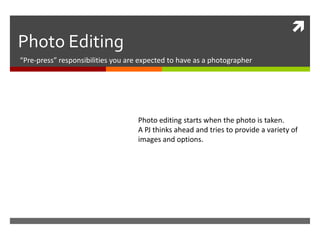
Photo Editing Tips
- 1. Photo Editing “Pre-press” responsibilities you are expected to have as a photographer Photo editing starts when the photo is taken. A PJ thinks ahead and tries to provide a variety of images and options.
- 2. Before you shoot You should be thinking about the needs of the story and the photos you can make that will tell the story best Cover the story fully – try to find effective images that include three basic shots of PJ: LS, MS and CU A large part of selecting photos is intuitive
- 3. Photographer as Editor Should an photographer edit his own photos? You were there and know what image captures the event But, you might be too involved with the photos and think an image says more than it really does So, review the photos together with your editor Provide your notes and detailed captions so the editor can make the best decision. Regardless, you should seek feedback on every shoot.
- 4. Sorting through your photos As a staff photographer, the photograph and the words are partners and should be selected to work together Go over your pictures at least twice. The first time, your eye will stop at any photos that might work. Note this. The second time, see if there are any shots that have small details or subtle messages that might not have jumped out at first (You might have to look at the large thumbnails or use a magnifier) A photo may look sharp when small but be fuzzy full screen
- 5. Judging your photos Three main points to look for when judging a photo: Message content, composition and technical quality Message content: make sure the photo is making a statement about SOMETHING and not merely a pretty picture. The message can be subtle. Watch for clichés (people just looking at camera) Be sure the photo accurately portrays the event and is not a moment out of context. Ask: what does this photo say about this event? What does it tell us about the atmosphere? Does it say enough? (Get a second opinion) Is the photo alive? Does it have impact? Is people are posing, is there a naturalness or do they look like stuffed turkeys? A common mistake is to capture only the backs of people.
- 6. Judging your photos Composition: check for photos that may look weak at first but can be cropped to turn into a strong image It’s possible to have a beautiful photo that does not tell a story and another that gets right to the point yet isn’t as well balanced or composed. A really good photo should read from 10 feet. The photo should have a strong element that can be readily seen and will grab the reader’s attention.
- 7. Judging your photos Technical quality – sharpness, well-exposed. Only once in a while will you have a picture that isn’t sharp yet the message overrides the consideration. Rarely. Exposure: details, details, details!
- 8. Sensitive issues Watch for things that could needlessly embarrass the subjects or you. Folds, wrinkles, sags in clothing. Sensitive issues also include photos of grief, tragedy, violence and private moments. Sometimes, you might run a photo without a story because it is so sensitive and you don’t have names…this is a tough call.
- 9. Editing Check for pairs of photos that can be used together. Be sure the images complement each other, not duplicate each other. Good uses for pairs include stories involving contrasts, times when a long shot also needs a close up, or when a sequence best explains the action. Long shots should make a point beyond being a wide- angle view of the scene, should have an impact and a dominant element that stops the reader and gives him or her solid information.
- 10. Cropping Crop intelligently. Crop in the camera, and when that fails, crop properly when publishing. Careless cropping can destroy a well-made image. Crop out empty or wasted space. Be careful about destroying balance and emotional feelings created by space. Crop for content – you should straighten out horizons, most of the time.
- 11. Cropping Avoid cutting off hands and feet. Avoid cropping so a major element just touches the frame. Either leave a little space between the element and the frame, or crop so the frame runs through the object.
- 12. Retouching Retouch photos CAREFULLY – the integrity of a news photo must not be breached. We will deal with ethics later, but you should not tamper with the honestly of the image. There’s a fine line between improving an image and falsifying it.
- 13. Captions Many cutlines are poorly written, so look through newspapers or magazines for examples. (Even those are bad, sometimes.) The camera can only go so far. Words go the rest of the way. So, why do photographers put such little effort into the other half of their job? Make a list of what you can’t see in the photo and use this as a basis for the caption. List reasons why the pictured event is happening, time context, quotes from the subject, names, place, date.
- 14. Captions Don’t repeat what is obvious the photograph. Try not to start every caption with a name. Include story facts in your cutline. Never say “is pictured” or “in the photo above.” Never say someone is “looking on.” Libel often happens because of the cutline: be sure names are accurate and the cutlines relates only to the photo. Don’t guess! If you aren’t positive, leave it out.
